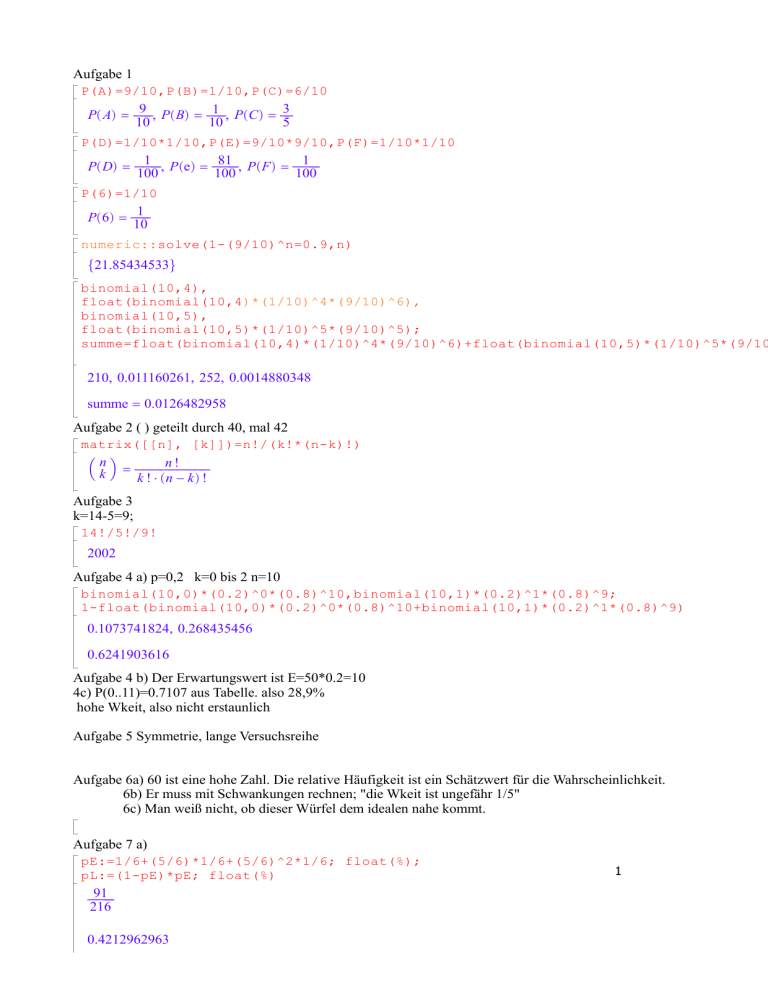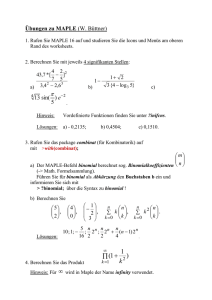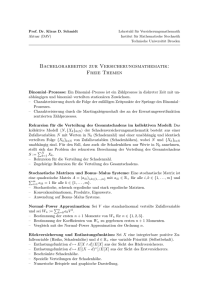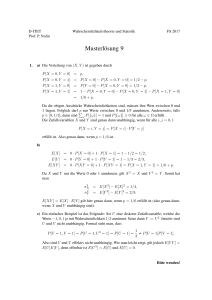ÅÅÅ 10ÅÅ ³n ÅÅÅÅÅÅÅÅÅ ÅÅÅ
Werbung

Aufgabe 1
P(A)=9/10,P(B)=1/10,P(C)=6/10
9,PB = 1,PC = 3
P A = 10
5
10
P(D)=1/10*1/10,P(E)=9/10*9/10,P(F)=1/10*1/10
1 , P e = 81 , P F = 1
P D = 100
100
100
P(6)=1/10
1
P 6 = 10
numeric::solve(1-(9/10)^n=0.9,n)
21.85434533
( ) ÅÅÅ ( ) ÅÅÅ ( ) Å
( ) ÅÅÅÅ ( ) ÅÅÅÅ ( ) ÅÅÅÅ
( ) ÅÅÅ
{ }
binomial(10,4),
float(binomial(10,4)*(1/10)^4*(9/10)^6),
binomial(10,5),
float(binomial(10,5)*(1/10)^5*(9/10)^5);
summe=float(binomial(10,4)*(1/10)^4*(9/10)^6)+float(binomial(10,5)*(1/10)^5*(9/10
210, 0.011160261, 252, 0.0014880348
summe = 0.0126482958
Aufgabe 2 ( ) geteilt durch 40, mal 42
matrix([[n], [k]])=n!/(k!*(n-k)!)
n
n!
k = k!× n-k !
³ ´ ÅÅÅÅÅÅÅÅÅ
( )
Aufgabe 3
k=14-5=9;
14!/5!/9!
2002
Aufgabe 4 a) p=0,2 k=0 bis 2 n=10
binomial(10,0)*(0.2)^0*(0.8)^10,binomial(10,1)*(0.2)^1*(0.8)^9;
1-float(binomial(10,0)*(0.2)^0*(0.8)^10+binomial(10,1)*(0.2)^1*(0.8)^9)
0.1073741824, 0.268435456
0.6241903616
Aufgabe 4 b) Der Erwartungswert ist E=50*0.2=10
4c) P(0..11)=0.7107 aus Tabelle. also 28,9%
hohe Wkeit, also nicht erstaunlich
Aufgabe 5 Symmetrie, lange Versuchsreihe
Aufgabe 6a) 60 ist eine hohe Zahl. Die relative Häufigkeit ist ein Schätzwert für die Wahrscheinlichkeit.
6b) Er muss mit Schwankungen rechnen; "die Wkeit ist ungefähr 1/5"
6c) Man weiß nicht, ob dieser Würfel dem idealen nahe kommt.
Aufgabe 7 a)
pE:=1/6+(5/6)*1/6+(5/6)^2*1/6; float(%);
pL:=(1-pE)*pE; float(%)
91
216
ÅÅÅÅ
0.4212962963
1
0.4212962963
11375
46656
ÅÅÅÅÅ
0.243805727
erfolgreicheRunde:=pE;float((1-erfolgreicheRunde)^3*erfolgreicheRunde)
91
216
ÅÅÅÅ
0.08165004468
Aufgabe 8 Hypothese p0=0.9;
n=20, annehmen bei 18,19,20
f8:=stats::binomialPF(20,0.9):DIGITS:=5:
float(f8(i)$i=18..20);
alpha=1-float(f8(18)+f8(19)+f8(20))
0.28518, 0.27017, 0.12158
alpha = 0.32307
annahme:=x->binomial(20,18)*x^18*(1-x)^2+binomial(20,19)*x^19*(1-x)+binomial(20,20
DIGITS:=4:float(1-annahme(i*0.1)$i=1..9);
1-annahme(x)=expand(1-annahme(x));
plotfunc2d(1-annahme,x=-0.1..1.02,Scaling=Constrained);
plotfunc2d(1-annahme,ViewingBox=[-1.3..1.3,-0.5..1.5],Scaling=Constrained)
1.0, 1.0, 1.0, 1.0, 0.9998, 0.9964, 0.9645, 0.7939, 0.3231
20 × x19 × x - 1 - x20 - 190 × x18 × x - 1 2 + 1 = - 171 × x20 + 360 × x19 - 190 × x18 + 1
( )
y
( )
1.0
0.9
0.8
0.7
0.6
0.5
0.4
0.3
0.2
0.1
-0.1 0.0 0.1 0.2 0.3 0.4 0.5 0.6 0.7 0.8 0.9 1.0
x
2
y
1.4
1.2
y
1.4
1.2
1.0
0.8
0.6
0.4
0.2
-1.2 -1.0 -0.8 -0.6 -0.4 -0.2
-0.2
0.2
0.4
0.6
0.8
1.0
1.2
x
-0.4
diff(1-annahme(x), x);factor(%)
380 × x18 × x - 1 - 190 × x18 × 2 × x - 2 - 3420 × x17 × x - 1
( ) ( )
( )
- 3420 × x17 × x - 1
2
( )
2
17fache NS bei x=0, also Extr dort, dopp NS bei x=1, also WP
Ideal wäre y=1 für alle x < 0.9, y=0 für alle x > 0.9 Testkurve bleibt
bis x=0.7 bei 1 und sinkt rasch ab, nicht ganz schlecht
Aufgabe 9
alpha: ablehnen obwohl wahr
Eine gute Methode würde nicht angewandt!
beta: annehmen obwohl falsch
Eine wertlose Methode würde angewandt, und weiterhin verstehen Generationen die binomischen Formeln
nicht.
alpha und beta schließen sich aus
alpha kleiner, dann beta größer
3


